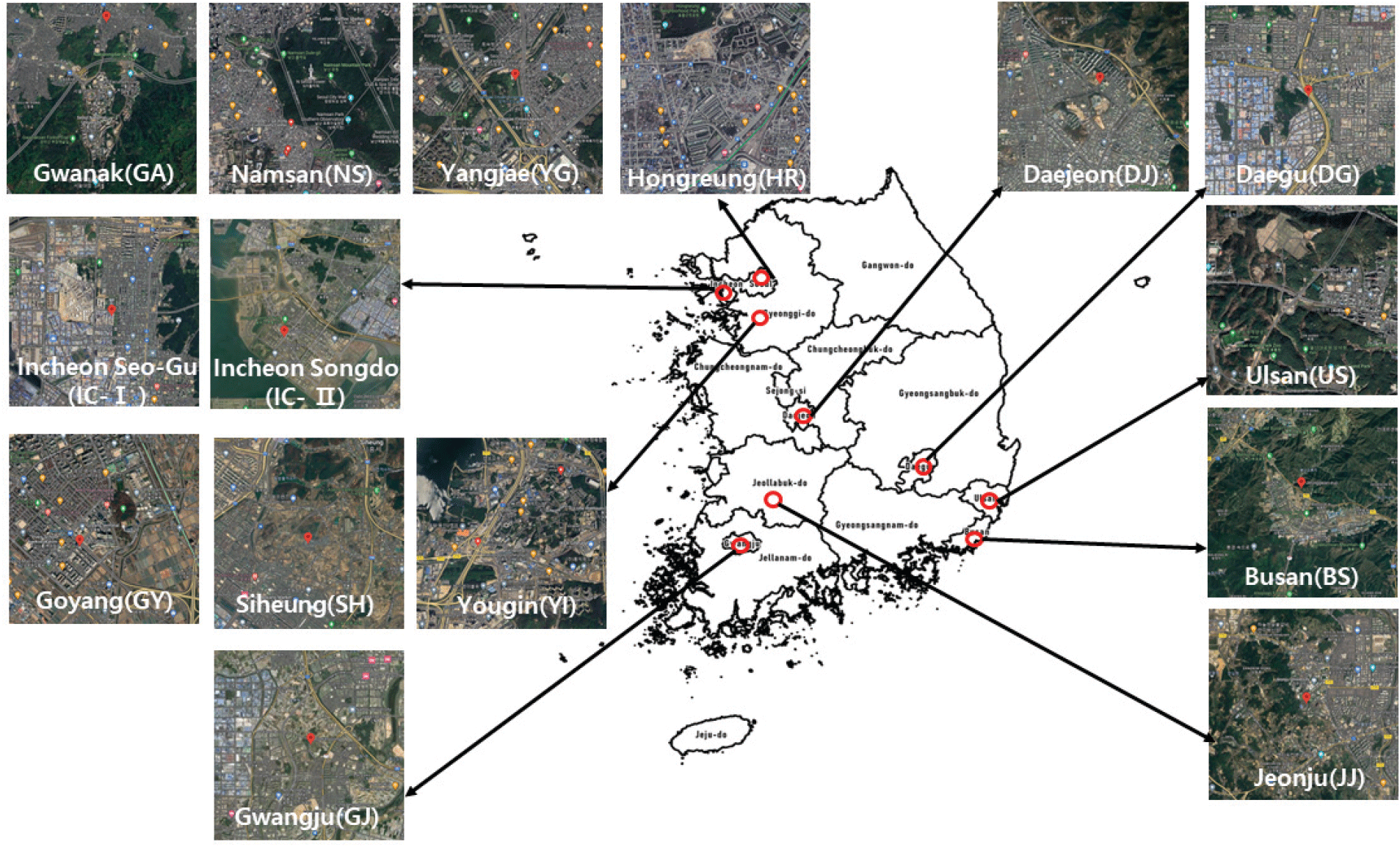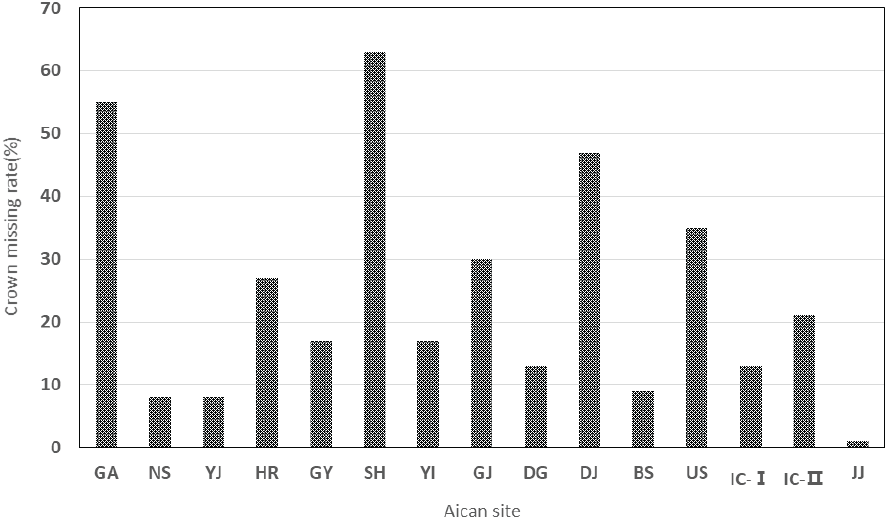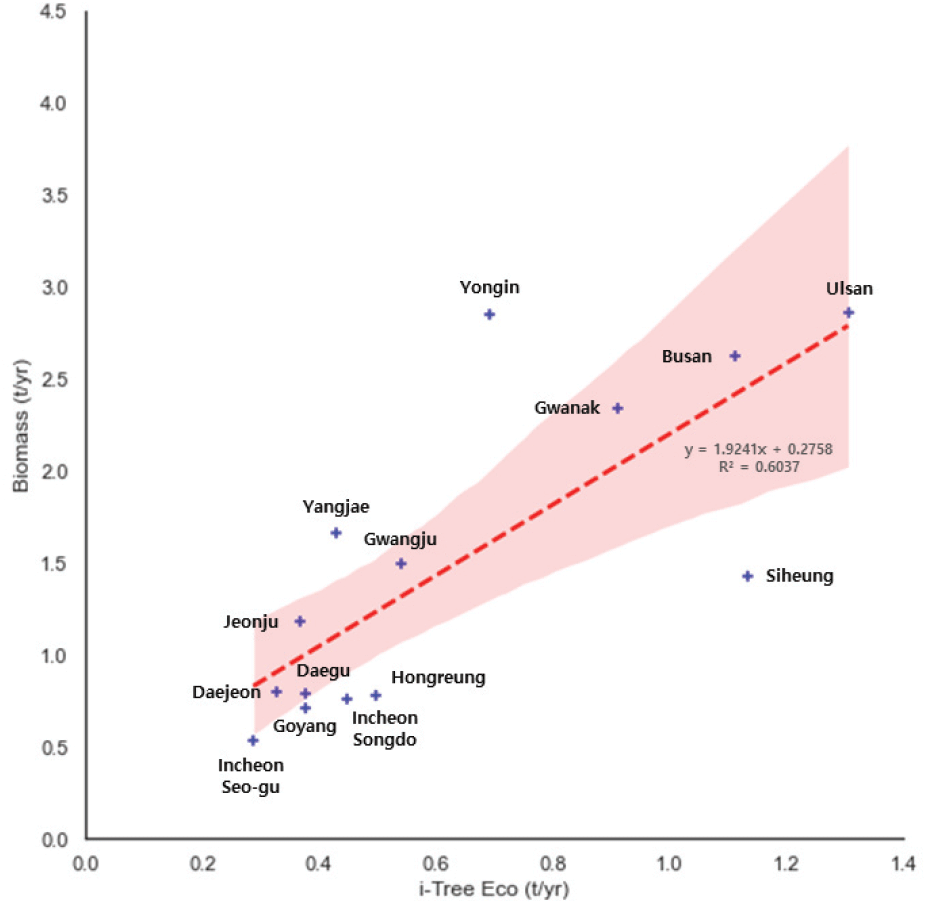서 론
급속한 도시화로 인해 도심 내 환경 문제가 발생하고 있다(Uttara et al., 2012). 운송, 에너지 생산 및 기타 인간 활동을 위한 화석 연료의 연소는 오존, 일산화탄소, 이산화황, 질소산화물, 미세먼지 등과 같은 대기오염물질을 발생시키고(Cohen et al., 2004), 이는 인체와 환경에 악영향을 줄 수 있다(Ghorani-Azam et al., 2016). 더불어 이산화탄소와 같은 온실가스도 배출하는데, 이는 기후변화의 큰 주범이기도 하다(Ramanathan and Feng, 2009).
이러한 도시내 환경문제를 줄이는 한 가지 방법은 도시 녹화를 통한 것이며, 많은 국가에서 나무를 심어 도시를 녹화하는 정책을 수행하고 있다(McPherson et al., 2001). 도심 내 녹지는 대기오염물질을 완화하는데 중요한 역할을 한다(Nowak et al., 2002a; Bottalico et al., 2016; Endreny et al., 2017). 나무는 잎 기공으로 흡입하거나 식물 표면을 통해 대기오염물질을 제거하고(Nowak et al., 2006a), 광합성을 통해 탄소를 고정(fixing)하고 여분의 탄소를 바이오매스 형태로 저장함으로써 탄소 흡수원으로의 기능을 한다(Nowak and Crane, 2002b). 이처럼 환경 오염 문제를 해결하고 다양한 순기능을 향상하는 도시숲의 긍정적 효과를 이해하고 정량화하는 것은 도심 내 식생을 관리하는데 중요한 정보이다(Nowak and Crane, 2000; Myeong et al., 2006).
도시 환경질을 개선하는 도시숲의 영향을 평가하는 모델은 현장에 실효적으로 적용가능한 식재 계획을 제시하고, 기존에 조성된 숲을 우선적으로 유지·관리할 지역을 파악하여(Lin, 2020), 한정된 예산에서 도시숲의 전반적 관리 체계를 개선하고 산림자원의 혜택을 정량화하여 표출할 수 있다(Nowak et al., 2006a).
이에 도시숲을 정량적으로 평가하기 위한 연구들이 실행되었다. 2008년 스페인 바르셀로나 내 수목을 대상으로 i-Tree Eco를 활용하여 월별, 오염물질별 대기 오염 제거, 탄소 저장량 등을 정량화하는 연구가 있었으며(Baró et al., 2014), 영국 런던 시내의 수목을 대상으로 i-Tree를 활용하여 환경적 가치를 평가한 연구 사례(Farrell, 2015)가 있다. 또한 미국의 백만 그루 프로젝트, 호주 도시의 캐노피 평가 및 커뮤니티 참여, 유럽 전역의 지방자치단체에서 i-Tree를 도시녹지를 가치 있게 평가하는 방법으로 사용하고 있다.
국립산림과학원은 미 농림부와 Davey Institutes와 협력하여 한국의 대기오염농도 및 기상 정보를 i-Tree Eco에 업데이트하고 국내 다양한 지역을 대상으로 도시숲의 환경·생태적 가치의 평가를 시도하고 있다.
본 연구는 국내 산림미세먼지측정넷 15개소를 대상으로, i-Tree Eco를 활용하여 해당 지역 내 도시숲의 대기오염물질 제거량, 탄소 저장량 및 흡수량, 산소 생산량, 유수 유출 방지량, 구조자산가치(Replacement values)를 추정하여 도시숲의 환경 개선 효과를 평가했다. 이후 국내 기존의 탄소 흡수량 식을 통해 계산한 값과 비교 검토하여 i-Tree Eco의 평가 값을 비교하였다. 본 연구의 결과는 향후 국내 도시 녹지 평가 시 i-Tree Eco를 적용하는 것에 긍정적인 영향을 줄 수 있을 것으로 판단된다.
재료 및 방법
2019년부터 2023년까지 국립산림과학원은 도시숲과 산림의 미세먼지 저감효과를 측정하기 위해 전국 44개소 132지점에 산림미세먼지측정넷을 구축하였다. 측정넷은 주풍방향 및 주변환경 조사를 통한 적지선정을 통해 1개소당 주거지-오염원-산림(도시숲)의 3개 지점에 설치하였다. 또한, 관측 데이터의 분석을 위해 2021년까지 설치된 측정넷 주변의 그린인프라를 조사하여 보고하였고(Choi et al., 2021), 본 연구는 그린인프라 조사지역 중 도시내 생활권에 위치한 도시숲과 공원 등 15개소(관악, 남산, 양재, 홍릉, 고양, 시흥, 용인, 광주, 대구, 대전, 부산, 울산, 인천 서구, 인천 송도, 전주, Figure 1)를 대상으로 하였다.
i-Tree Eco를 활용하여 수목의 탄소저장량, 대기오염물질제거 등의 항목에서 평가하기 위해서는 수목에 대한 자세한 데이터를 입력해야 한다(Table 1)이다. 특히, 탄소저장량을 산정하기 위해서는 수목 기본정보 이외에도 수목명, 낙엽성인지 상록성인지, 상대생장식 등이 입력되어야 한다. i-Tree Eco에는 기존에 누락되었던 국내 몇 수종에 대한 상대식과 수종에 대한 정보가 반영되어 있어 국내 실정에 맞게 평가할 수 있도록 구성되어 있다. 본 연구에서는 각 지점별 수목조사한 데이터를 입력하여 분석을 했으며, 현장수목조사 항목 및 방법은 ‘i-Tree Eco 기반 도시숲의 가치 평가 및 조사 방법(Gwak et al., 2020)’에 따라 수행하였다. 조사대상지는 각 지역별 3개 지점을 3반복으로 조사하는 것을 원칙으로 하였으나, 측정넷 장비가 옥상이나 건물 또는 타워에 설치된 장소(관악, 홍릉, 고양, 대전, 인천 서구)는 각 1개의 지점이 제외되었다. 용인지역은 1개의 지점에 장비 3대가 설치되어 있어 수목조사 또한 1개 지점에 대해서만 수행하였다. 수목조사 대상지는 산림미세먼지측정넷이 설치된 곳의 환경 및 여건을 반영하여 선정하다 보니, 조사 면적은 달랐다. 항목 중 수종(Species), 흉고직경(DBH), 수목 주소(Tree address), 토지이용(Land Use), 지층/면적(Strata/Area), 가로수여부(Street tree/non-street tree), 수고(Total tree height), 수관높이(Crown Height to live top), 수관기저고(Crown Height to crown base), 수관폭(Crown width), 수관손실률(Percent crown missing), User Tree ID를 수목 정보로 입력했다.
| Minimum Requirements | General Site Fields | Tree Detail Fields | Management Fields |
|---|---|---|---|
| Species | Tree address | Total tree height | User Tree ID |
| DBH | Land Use | Crown size | |
| Strata/Area | |||
| Street tree/non-street tree | |||
i-Tree Eco는 미국 산림청(U.S.D.)과 Davy Institute가 개발한 i-Tree 프로그램 도구 중 하나로, 국립산림과학원은 국제공동연구를 통해 국내 수목, 도시숲, 산림 등의 녹지를 평가할 수 있도록 수종정보, 위치정보, 대기오염물질, 기상정보, 오존, 알베도값 등의 국내 데이터를 i-Tree Eco 프로그램에 반영하였다. 이러한 한국형 i-Tree 프로그램은 특·광역시 단위 뿐만아니라, 시·군·동·면 또는 어느 특정 녹지면적에 대해 그 가치를 평가할 수 있게 되었다. 대기오염 및 기상 정보는 2018년 데이터를 활용하여 평가하였다. 한국형 i-Tree 프로그램 평가를 위한 과정은 Figure 2와 같으며, i-Tree Eco에서 서비스 항목별 산출값을 얻기 위해 조사해야 하는 항목(즉, 측정값을 입력해야 값을 얻을 수 있음)을 버전 6.0 기준으로 정리하였다(Table 2).
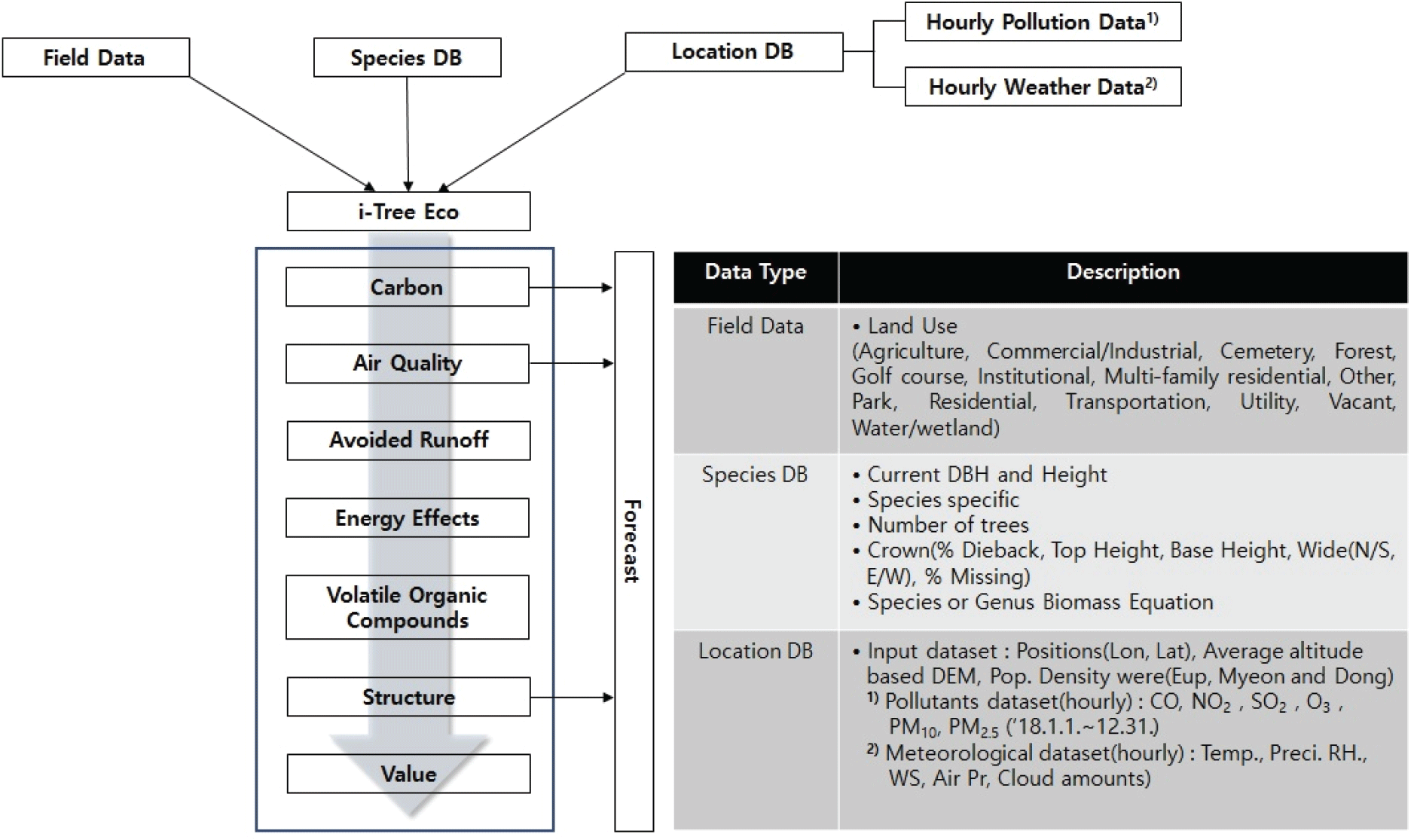
D Directly used I Indirectly used C Conditionaly used
본 연구에서는 각 지역별 그린 인프라의 대기오염물질 제거(Air Pollutants Removal), 탄소 저장 및 흡수(Carbon Storage and Sequestration), 산소 생산(Oxygen Production), 유수 유출 방지(Avoided Runoff), 구조자산가치(Replacement Values)를 산출했다. 각 항목의 정량적인 수치와 경제적 가치를 산출하는 방법은 다음과 같다.
대기오염물질은 오존(O3), 이산화황(SO2), 이산화질소(NO2), 일산화탄소(CO), PM10, PM2.5로 구성된다. 해당 항목의 추정치는 큰 잎(big-leaf)과 다층 캐노피 침강 모델(multi-layer canopy deposition models)를 하이브리드한 방법을 기반으로 오존과 황 및 이산화질소의 시간당 수관층 저항(tree-canopy resistance)으로부터 도출된다(Baldocchi, 1988; Baldocchi et al., 1987). 식물에 의한 일산화탄소와 미세먼지의 제거는 증산과 직접적인 관련이 없기에, 오염 물질의 제거율(removal rates)은 잎 생물계절학(leaf phenology)과 잎 면적에 따라 조정된 평균 측정 값을 기반으로 추정된다(Bidwell and Fraser, 1972).
대기오염물질 제거의 경제적 가치 추정은 사용자의 거주 국가 오염 값(user-defined local pollution values)을 사용한다. 지역 값(local values)가 없는 경우 European median externality values(Van Essen et al., 2011)이나 BenMap regression equations을 기반(Nowak et al., 2024)으로 추정한다. 이후 해당 국가의 환율에 맞추어 경제적 가치로 환산된다.
대기오염물질저감량(F, g/m2/s)은 대기 중 오염물질 농도(C, g/m3)와 오염물질 침강속도(Vd, m/s)를 활용하여 다음과 같은 식으로 계산된다.
Ra = 공기역학적 저항, Rb = 준층류경계층 저항,
Rc = 수관층 저항(대기오염물질별로 상이)
공기역학적 저항(Ra)과 준층류 경계층 저항(Rb)은 표준 저항 수식(Killus et al., 1984; Nowak et al., 1998; Pederson et al., 1995)과 시간당 기상 데이터를 기반으로 추정된다. 수관층 저항(Rc)은 대기오염물질별로 상이하며, NO2, SO2, O3에 대한 Rc는 수목 부위별 대기오염물질에 대한 저항값(rs, rm, rt)을 기반으로 다음과 같이 산출된다(Baldocchi et al., 1987; Baldocchi, 1988).
rs= 기공저항, rm= 엽육저항, rt= 큐티클저항
엽육저항(rm, s/m)은 SO2에 대해 0으로(Wesely, 1989), O3에 대해 10으로(Hosker and Lindberg, 1982), 그리고 NO2에 대해 100으로 적용된다(Lovett, 1994). 큐티클저항(rt, s/m)은 SO2, O3, NO2에 대해 각각 8,000, 10,000, 20,000으로 적용된다(Lovett, 1994). 기공저항(rs)은 시간당 광합성유효복사(photosynthetically active radiation, PAR, μE/m2/s), 기온(K°), 풍속(m/s), 마찰속도(u*, m/s), CO2 농도(390 ppm), 절대 습도(kg/m3)를 활용하여 산출된다.
식물에 의한 일산화탄소와 미세먼지(PM10, PM2.5) 저감은 증산과 직접적인 관련이 없으므로 오염 물질의 제거율(removal rates)은 잎 생물계절학(leaf phenology)과 잎 면적에 따라 조정된 평균 측정 값을 기반으로 추정된다(Bidwell and Fraser, 1972). 즉, Rc 및 Vd값을 다수의 선행연구를 참고하여 상수로 설정하였다. 일산화탄소에 대한 Rc(s/m)는 잎의 유무에 따라 각각 50,000(잎이 있는 계절), 1,000,000(잎이 없는 계절)를 적용하며(Bidwell and Fraser, 1972), PM10에 대한 침강속도(Vd, m/s)는 기본적으로 대기 중 재부유율(resuspension percentage) 50% 기준으로 0.064로 설정하였으나, 잎의 유무에 따라 조정된다(Zinke, 1967). PM2.5에 대한 침강속도 및 재부유율은 Nowak (2013)를 참고하여 풍속에 따라 다르게 적용하였다(Table 3).
대기오염물질 제거의 경제적 가치 추정은 사용자의 거주 국가 오염 값(user-defined local pollution values)을 사용한다. 지역 값(local values)가 없는 경우 European median externality values(Van Essen et al., 2011)이나 BenMap regression equations을 기반(Nowak et al., 2024)으로 추정한다. 이후 해당 국가의 환율에 맞추어 경제적 가치로 환산된다.
탄소 저장은 산림 및 도시숲을 이루는 수목의 지상 및 지하 부분에 저장된 탄소의 양으로, 이를계산하기 위해 각 수목의 탄소 방정식과 측정값을 사용하여 바이오매스를 계산한다. 개방된 곳에서 자라는 수목은 산림 수종의바이오매스식(forest-derived biomass equations)에 의해 예측된 값보다 적은 경향이 있기때문에(Nowak, 1994), 추정값에 0.8을 곱한다. 개방형 수목은 다른 나무와 공간이나 자원을 두고 경쟁하지 않는환경에서 자란 나무를 의미하며, 주로 공원, 주택 정원 또는 거리와 같은 개방된 공간에서 자란다. 탄소 흡수는 식물에 의해대기 중에서 제거된 이산화탄소를 의미한다. 연간 탄소 흡수량을 추정하기 위해 기존의 나무 직경(year x)에 적절한속(genera) 및 경급(diameter class)과 나무 상태(tree condition)를 추가하여 다음 연도(year x+1)의 수목 직경 및 탄소 저장량을 추정한다.
탄소 저장 및 흡수량의 경제적 가치는 추정값 또는 각 해당국가의 탄소 값을 기반으로 계산된다. 지역 값이 없는 경우, 미국의 탄소 값(U.S. Environmental Protection Agency 2015, Interagency Working Group on Social Cost of Carbon 2015)을 기반으로 해당 국가 환율에 맞추어 환산한다.
i-Tree Eco 프로그램에서는 수목의 필수입력자료(수종, 흉고직경)를 기반으로 구한 총 건중량에 전환계수 0.5를 곱하여 수목의 탄소저장량(㎏)을 추정한다(Chow and Rolfe, 1989).
연간 탄소흡수량은 1년간 수목이 흡수하는 탄소량(kg/yr)을 의미한다.
산소 생산량은 원자량과 탄소 흡수량을 기반으로 추정한다(Nowak et al., 2007d).
순탄소흡수율(Net carbon sequestration rate)를 추정하기 위해, 수목 성장의 결과로 흡수된 탄소의 양(the amount of carbon sequestered)은 수목 고사로 인한 손실량만큼 감소한다.
연간 유수 유출 방지량은 식생에 의한 강우 차단(rainfall interception), 특히 식생이 있을 때의 연간 유출량과 없을 때의 유출량 간의 차이를 기준으로 계산한다. 주로 수목의 잎, 가지, 껍질이 강수를 차단시켜 표면 유출을 완화 시키는데, i-Tree에서는 잎에 의한 차단량만을 계산한다.
지역 값이 없는 국가의 경우 미국의 국가 평균값을 기반으로 해당 국가 환율에 맞추어 환산한다(McPherson et al., 1999; 2000; 2001; 2002; 2003; 2004; 2006a; 2006b; 2006c; 2007; 2010).
구조자산가치(Replacement Values)는 분석 대상지의 수목을 유사한 수목으로 교체할 때 드는 비용으로, 수종(Tree Species), 직경, 상태(condition), 지역 정보(location information)를 고려하는 CTLA(the Council of Tree and Landscape Appraisers)의 평가 절차를 기반으로 계산한다(Nowak et al., 2002a; 2002b).
국내 도시 수목의 이산화탄소 흡수량을 계산하는 상대생장식은 다음과 같다(Lee, 2003). 이산화탄소 흡수량은 수목의 연간 평균 직경생장률로 침엽교목 0.64 cm(Jo, 1999; Son et al., 1997; Park, 1987; Jeong et al., 1985), 활엽교목 0.67 cm(Jo, 1999; Son et al., 1997; Jeong et al., 1985)를 사용하여 그 변화량을 흉고직경의 함수로 다시 표현한 것이다.
BT1 : Y = −4.2136 + 1.9006 DBHaver. - 0.0068 DBHaver.2
BT2 : Y = −2.7714 + 0.9714 DBHaver. - 0.0225 DBHaver.2
BS1 : ln Y = −3.4025 + 1.5823 lnDBHaver.
BS2 : ln Y = −2.8689 + 1.3350 lnDBHaver.
결과 및 고찰
전국 특·광역시, 지자체 중 산림미세먼지측정넷 지점주변의 15개 사이트 38개 지점을 조사한 결과, 총 면적 1.74 ha, 총 수목 개체수는 2,057본으로 침엽수 982본, 활엽수 1,075본을 조사하였다(Table 4). 각 지역마다 다양한 토지형태, 오염원, 수종 등이 조사되었다. 토지유형은 IPCC(%) 기준 산림지 9개 지역, 초지 5개 지역, 초지 및 기타 1개 지역으로 조사되었다. i-Tree에서 구분하고 있는 지표(land cover, %)유형 기준으로는 낙엽층 5개 지역, 낙엽층 및 바위 1개 지역, 초지 4개 지역, 관리되지 않는 초지 3개 지역, 아스팔트 및 잔디 1개지역, 잔디 1개 지역으로 조사되었다. 대상지의 지점 중 면적내 수종을 전수 조사하였고, 각 지점별 조사된 수종 중 우점종에 대한 수종명, 평균 수고(m), 평균 흉고직경(cm), 수관폭, 수관 손실율에 대해 조사하였다(Table 4). 100본 이상 조사된 지역의 우점종 특성은 관악산(GA)은 리기다소나무(Pinus rigida)가 우점하고 있었으나, 수관에 대한 손실율이 55% 정도로 수목의 건강관리가 필요한 상태였다. 남산(NS)은 교목은 소나무(Pinus densiflora), 아교목층은 당단풍나무(Acer pseudosieboldianum)가 우세하고 있었다. 시흥(SH)은 차단숲의 경우 곰솔이 많이 식재되어 있었으나 수관손실율이 63%로 다른 지역에 비해 높게 조사되었다. 부산(BS) 완충숲의 경우 비목나무(Lindera erythrocarpa)와 소나무가 우점하고 있었으며 손실율(각각 9%, 1%)이 적게 조사되었다. 울산(US)숲은 소나무(Pinus densiflora)가 우점하고 있었으며 수관 손실율은 35%정도로 조사되었다. 평균 흉고직경(DBH)이 30 cm이상의 수종이 분포하는 지역은 홍릉(HR), 대구(DG), 부산(BS), 10 cm이하가 조사된 지역은 관악(GA), 대구(DG), 부산(BS), 인천서구(IC-Ⅰ)로 파악되었다. 관악(GA)의 경우 조사면적내 개체수는 많으나 흉고직경과 수고가 낮은 수종이 많이 분포되어, 밀도가 높은 구조를 가지고 있었다.
The 15 AiCANs are all non-street tree. HT is the total tree height and CB is the Crown Base Height.
IPCC GPG LULUCF(%) land use types : Forest land, Cropland, Grassland, Wetlands, Settlements, Other land, Remarks
i-Tree Land cover(% land use types : Bare soil, Building, Cement, Tar, Rock, Duff/mulch, Grass, Unmain grass, Herbs, Other impervious, Water
i-Tree Eco는 수목의 종과 구성, 잎면적과 수목의 건강성 등의 인자를 사용하여 도시숲이나 나무가 제공하는 생태서비스를 평가할 수 있는 프로그램 이다. 산림미세먼지측정넷 15개소의 수목 정보를 바탕으로 i-Tree Eco 분석을 수행하여 각 개소의 중요 수종의 빈도율(%), 엽면적율(%), 중요치에 대한 분석과 조사된 전체 개체의 엽면적(ha)을 분석 하였다(Table 5). 또한, 각 개소의 대기오염물질 제거, 탄소 저장 및 흡수, 산소 생산량, 유수 유출 방지량, 구조자산가치와 이들의 경제적 가치를 구한 뒤 지역별 수목 조사 면적을 나누어 단위 면적당 결과를 도출했다(Table 6).
GA(Gwanak), NS(Namsan), YJ(Yangjae), HR(Hongreung), GY(Goyang), SH(Siheung), YI(Yongin), GJ(Gwangju), DG(Daegu), DJ(Daejeon), BS(Busan), US(Ulsan), IC-I(Incheon Seo-gu), IC-II(Incheon Songdo), JJ(Jeonju)
15개 지역 중 엽면적이 가장 높게 조사된 지역은 울산(US, 2.488 ha)으로, 인천 서구(IC-Ⅰ, 0.4022)로 가장 낮게 분석되었다. 대기오염물질은 시민의 건강 뿐만 아니라 생태계의 건강에도 영향을 끼친다(Tzoulas et al., 2007). 나무는 매년 다량의 입자상 물질, 질소산화물, 황화물을 흡수하고 여과할 수 있다(Nowak et al., 2006a; Nowak, 2002c). i-Tree는 나무가 정화한 공기 중 다양한 오염물질의 총량을 정량화하고 추정할 수 있다(Hirabayashi et al., 2012). 15개소의 대기오염물질 제거량을 분석 결과 울산(US)이 연간 약 504.6 kg/ha로 15개 지역 중 가장 많이 제거하였고, 다음으로 고양(GY, 418 kg/ha), 시흥(SH, 291 kg/ha)순으로 높게 분석되었다. 경제적 가치는 고양(GY)이 71,333,333원으로 가장 높게 산정되었고, 다음으로는 광주(GJ, 43,111,111원)로 분석되었다. 대기오염물질은 오염원이 산업단지, LNG 등 오염물질을 많이 발생하는 지역이 저감량과 경제적 가치가 높게 환산이 되었다.
무기물을 유기물로 전환하고 산소를 방출하는 광합성과정에서 공기 중 이산화탄소가 감소할 뿐만 아니라 산소도 생성되어 공기 중 탄소와 산소의 균형을 유지한다. 연간 탄소 흡수 능력을 보여주는 연간 탄소흡수량은 나무 크기, 건강 상태, 수관면적 및 공간 분포와 관련된 i-Tree Eco로 계산할 수 있다(Song et al., 2020). 15개소의 탄소 저장량과 흡수량을 평가한 결과, 탄소 저장량(210.22 t/ha)과 흡수량(12.59 t/년/ha), 그리고 이의 경제적 가치(48,000,000원, 2,866,667원), 산소 생산량(33.56 t/년/ha)과 구조자산가치(803,333,333 원/ha)에서 시흥(SH)이 가장 높게 평가되었다. 같은 수종에 있어서 직경이 큰 나무들은 숲의 구조 및 기능에 큰 영향을 미친다(Lutz et al., 2013). 시흥(SH)은 수관손실율(63%)은 높았으나, 개체수가 많이 조사된 상록침엽수인 곰솔(흉고직경 20 cm 이상, 수고가 10 m 이상)이 다른 개소에 비해 규격이 큰 영향으로 판단된다(Figure 3). 미국의 여러 도시에 식재된 나무에 의한 총 탄소흡수량를 평가한 Nowak et al.의 연구에 따르면 워싱턴 DC, 캐스퍼, 샌프란시스코, 필라델피아, 뉴욕의 나무에 의한 총 흡수량은 약 16,200톤(Nowak et al., 2006a), 1200톤(Nowak et al., 2006c), 5200톤(Nowak et al., 2007a), 16,100톤(Nowak et al., 2007b), 42,300톤(Nowak et al., 2007c)으로 평가되었다.
전세계적으로 도시홍수는 빈번하게 발생하고 있으며(Kubal et al., 2009; Yin et al., 2015), 도시에서 나무가 유수 유출을 감소시키는 역할을 한다는 많은 연구가 보고되었다(Wang et al., 2008; Armson et al., 2013; Zhang et al., 2015). 15개소의 유수 유출 방지량은 울산(US)에서 783.33 m3/년/ha(2,205,556원/년/ha) 가장 높은 값으로 산정되었다. i-Tree Eco 모델의 추정 결과는 수목의 크기(DBH, 엽면적, 수관폭)가 유수 유출 방지량을 결정하는 가장 중요한 요소이다(Sally et al., 2020). 수목조사에서 울산(US)은 관악(GA)과 조사된 수목이 개체수가 342본으로 다른 지역에 비해 가장 많이 조사되었으나, 활엽수와 침엽수가 고루게 조사되었고, 흉고직경(DBH)와 수고(HT), 수관폭(CB), 엽면적이 관악(GA)보다는 울산(US)이 더 큰 수목들이 조사된 영향으로 판단된다(Figure 4).
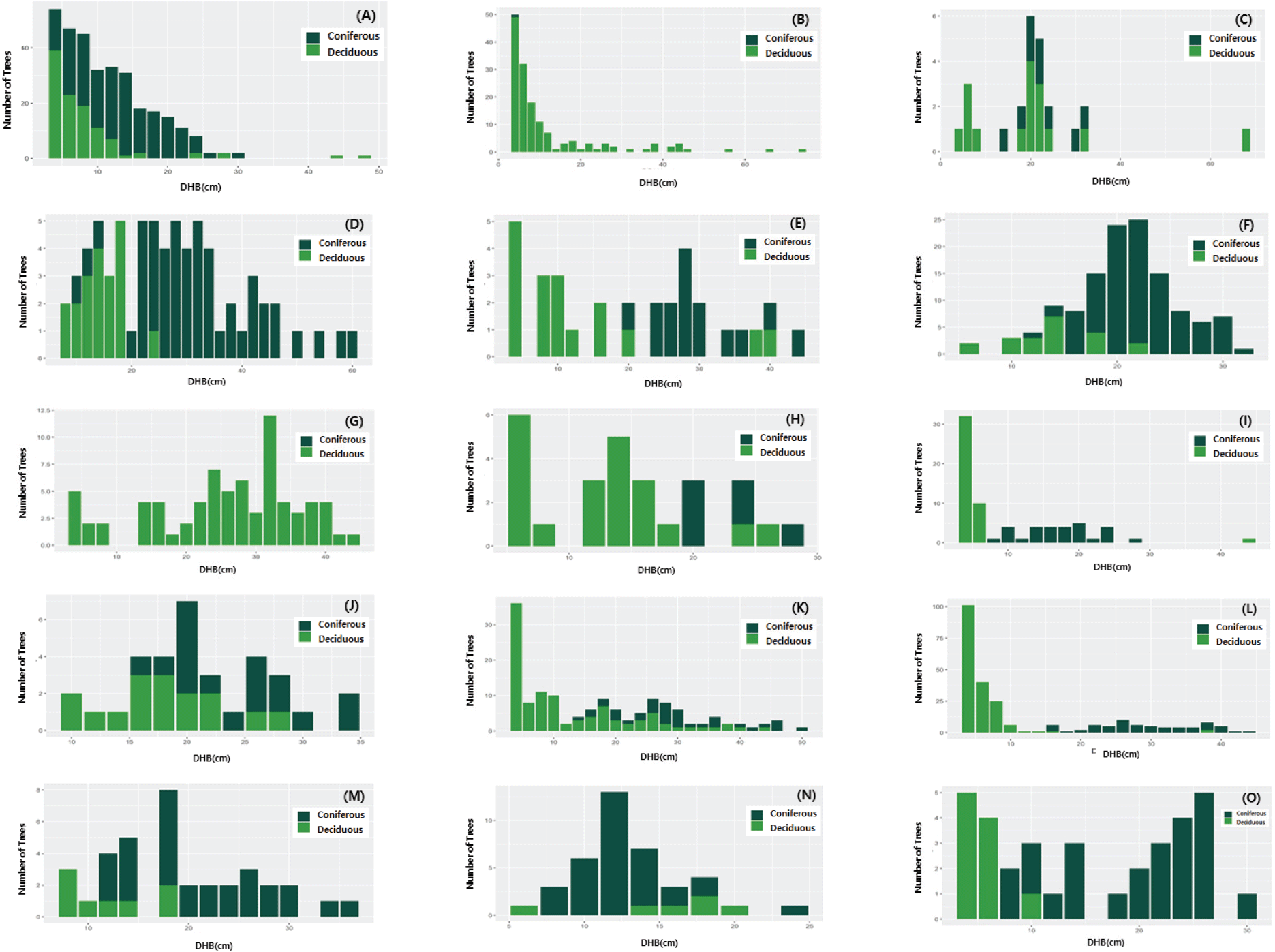
도시와 산림의 나무는 자라는 환경과 관리 수준 등에 따라 차이가 있다. 특히, 도시의 나무는 생활권에 식재되어 오염원에 노출, 제한된 식재환경과 인위적인 관리 등으로 같은 수종, 같은 수령의 나무여도 산림의 수종과 크기와 생장 상태가 차이가 날 수 있다. 도시에서 개방 생장하는 조경 수목을 대상으로 개발한 수종별 계량모델(Jo and Cho, 1998; Jo, 2001; 2002; 2019; Jo and Ahn, 2001; 2012; Jo et al., 2013; 2014; 2019b; 2019c)에 대한 연구가 진행되었다.
도시의 다양한 녹지(도시숲, 공원, 가로수 등)의 가치를 평가할 수 있는 (Lee, 2003)에 적용하여 i-Tree Eco 결과와 비교를 해보았다(Figure 5). 비교 과정 중 남산(NS)의 경우 수목 조사 지점 간 수고의 편차가 큰 이유로 제외하였다. 그 결과 전반적으로 유의미한 상관관계가 있다는 것을 알 수 있었다(R2 = 0.6037). 또한, 두 결과 간의 95% 신뢰구간에 관악(GW), 광주(GJ), 대구(DG), 대전(DJ), 부산(BS), 울산(US), 전주(JJ) 7개 지역이 포함되는 것을 알 수 있었다. 도시에서 생장 중인 단위면적 탄소흡수 및 저장량은 식재수량과 크기에 비례한다(Jo and Park, 2017; Jo et al., 2019a)고 보고된 바 있다. 이러한 결과는 i-Tree Eco가 국내 도심 녹지의 가치를 적절하게 평가할 수 있음을 설명하고 동시에 한국의 환경적인 특징에 적합한 i-Tree 해석 및 활용의 필요성을 시사 한다고 볼 수 있다. 하지만, 향후 효과성을 높이고 국내 도입을 위해 정확도를 높이기 위해서는 검증을 위한 연구가 지속적으로 수행되어야 할 것이다.
결 론
본 연구는 산림미세먼지측정넷 15개소의 수목 조사 자료를 기반으로 i-Tree Eco를 활용하여 이들의 수목 혜택(Tree Benefits)과 경제적 가치를 평가하고자 수행했다. 그 결과 시흥(SH)에서 탄소 저장량과 흡수량, 산소생산량 구조적가치가 가장 높게 나타났고, 미세먼지 저감량과 유수 유출 방지량은 울산(US)에서 가장 높은 값을 보였다. 특히, 울산(US)은 주요 조사된 소나무의 크기(흉고직경, 수고 등)가 큰 개체가 많이 조사되었고, i-Tree Eco를 통해 분석에서도 소나무의 중요도가 높고 잎면적도 약 2.49 ha로 다른 지역에 비해 가장 높게 분석되었다. 물론 측정넷 설치지점 주변의 수목을 조사한 자료를 통해 평가한 지역의 전부를 대표할 수는 없지만, 지역에 환경과 수목특성에 따라 도심 녹지의 수목 혜택(Tree Benefits)을 평가 할 수 있었다. 국내 탄소 흡수량 산정식을 활용해 동일한 수목 정보를 입력하여 계산한 결과와 i-Tree Eco의 탄소 흡수량 결과와 비교한 결과 전반적으로 좋은 상관관계를 보이는 것으로 나타났다. 그러나 더 정확한 국내 도심 녹지 평가를 위해서는 꾸준히 국내 대기오염농도 및 기상 데이터를 업데이트하고, 국내 수종 및 환경에 알맞은 수목 혜택(Tree Benefits) 산정식을 개발하여 i-Tree에 적용하고 검증하는 과정이 수행되어야 할 것이다. 본 연구는 한국형 i-Tree Eco 프로그램을 활용하여 국가 단위 또는 특·광역시, 지자체, 읍·면·동 등 큰 단위면적에서 작은 단위면적까지 대상지에 대한 환경적 및 경제적 가치를 평가하고 검증하고자 수행하였다. 본 연구는 각 도시의 측정넷지점 주변의 조사구를 선정한 수목조사결과를 평가한 것으로, 향후 도시 전체의 도시숲 면적에 대한 평가가 이루어져야 할 것이다. 또한, i-Tree Eco는 미국에서 개발된 프로그램으로 국립산림과학원과 국제공동연구 추진을 통해, 한국실정에 맞게 평가할 수 있도록 중요 인자를 개선하였다. 하지만, 포함되지 못한 홍수조절 효과 변수 등에 대한 지속적인 개선이 필요하다. 그리고, i-Tree 프로그램(Eco, Canopy, Mytree 등)의 다양한 도구(tool)를 제대로 이해하고 활용할 수 있도록 국내 사용자의 인식개선도 요구된다. i-Tree Eco는 각 국의 도시정책의 의사결정과 도시숲의 관리 과정에서 사용되고 있다(Raum et al., 2019). 따라서 국내에서도 도시숲 등의 정책적 의사결정 및 도시숲의 긍정적인 인식 개선에 활용하고, 동일한 수목에 대해 국외 사례와 비교가능한 툴로써 활용가치를 높여야 할 것이다.
